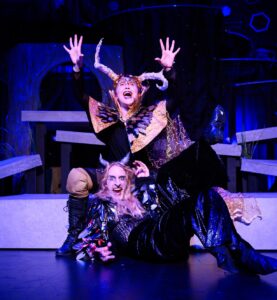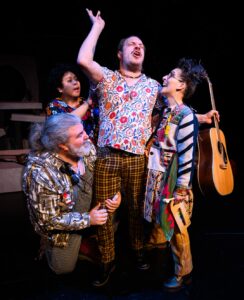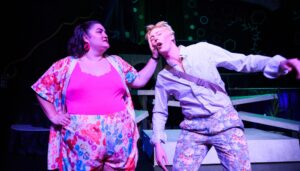A Midsummer Night’s Dream
William Shakespeare
Shotgun Players

With costumes wonderfully strange, weird, and entirely fanciful and a setting that is dark, mystical, and mysterious as a vast forest in a dream might be, Shotgun Players opens A Midsummer Night’s Dream with a cast that bends genders, mixes races, and celebrates diversity in almost every dimension possible. As directed with spark and spunk by William Thomas Hodgson, Shakespeare’s oft-performed, much-loved comedy of love spats and mishaps; fairy shenanigans; and a hilarious play within the play performed by four hapless, lovable working blokes is full of Shotgun’s own brand of hilarity and heart, magic and music, love illusive and love finally found.
For someone who has not attended quite the dozen or more productions of Dream as have I, let me provide a quick summary. Duke Theseus of Athens is about to marry the Amazon queen, Hippolyta whom he has just conquered in a battle – a ferocious fight on the field cleverly inserted by Director Hodges into this production before the actual play begins.
As the Duke and former Queen prepare for their wedding, Hermia, who is secretly about to be engaged to Lysander, resists her mother’s insistence that she instead marry Demetrius who just broke up with her best friend, Helena, because he loves Hermia. Helena, on the other hand, only has eyes for Demetrius, who wants nothing of her.
Hermia’s mother is enraged and insists the Duke force her daughter to marry her choice of Demetrius or condemn her daughter to death, as is commanded by an ancient, Athenian law. The Duke suggests a nunnery instead, leading Hermia to plan a late-night escape with her intended Lysander. She tells Helena her plans, who decides to betray her best friend to Demetrius, hoping foolishly that he may repay her with more attention and maybe even love.
As all hell is about to break loose when the four mixed-up lovers head to the forest, in the heavens above Oberon, King of the Fairies, voices his frustration with his estranged wife, Titania, who is planning on attending the Duke and Queen’s wedding. Oberon plans with his trickster sidekick, Puck, a way to punish his wife by using a flower’s potion to cause her to fall in love with the first beast of the forest she sees after waking from a night of slumber. Oberon also wants to help the two couples roaming in the forest straighten out their love issues and sends Puck on a mission also to remedy that situation, which of course he will unwittingly only make worse.

In the third parallel story, four common laborers begin a bumbling rehearsal of a play they hope to stage the night of the Duke’s wedding. Their choice is an ill-fated love story by Ovid, described by the tawdry troupe’s organizer, Quince, as “the most lamentable comedy and the most terrible death of Pyramus and Thisbe.”
In any production of A Midsummer Night’s Dream, there is much hilarity to come as Puck uses the love flower potion to cause Lysander (not Demetrius) to fall in mad love with Helena (leaving poor Hermia with no one), as Titania ends up falling in love with an ass (one of the laborers, Bottom, given the head of a donkey by a devilish Puck), and as our thespians lead up to their big world premiere in front of the Duke and his bride. In this Shotgun rendition, the miscues, missteps, and mix-ups are multiplied by the comedic prowess of both the director and of individual cast members who find a multitude of ways to exaggerate and explode the prompts provided in the Bard’s classic script.

The four confused lovers have been masterfully cast to stretch our imaginations with their collective diversity and to tickle our innards with their individual and collective comic flairs. Celeste Kamiya commands the stage every time Hermia is anywhere to be seen. As the protesting daughter not about to marry Demetrius, she is impetuous and defiant like the most stubborn of teenagers. Around her doting Lysander, she melts; but under the spell of Puck’s tricks, she bristles and fights like an ally cat to ward off Helena from their now-mutual target of Demetrius.

Equally delicious in the over-the-top in hilarity battle for Demetrius is Rolanda D. Bell as Helena, who rises to all sorts of giant moves and manners as her Helena believes everyone around her is mercilessly mocking her to no end. Her Helena wins a special note of praise for delivering the Bard’s lines with striking elocution in an impressively wide variety of vocal emphases and exactness.
Their common, spell-induced focus for sought-love is Demetrius, played with delectable air of narcissistic haughtiness and superiority by Fenner Merlick. Demetrius and Lysander also find themselves in a fiercely funny battle-of-sorts as each now is seeking in the trick-filled forest the love of Helena. The earlier doting-on-Hermia, Lysander, goes from puppy to bulldog in demeanor as Devin A. Cunningham steps at the last minute into the role of Lysander, splendidly and admirably performing with script in hand during the opening weekend, showing much humor and hubris

With waist-length hair that swirls in all directions as his rubber-like, pliable body bends, leaps, crawls, and folds into knots and balls all around the multi-level set, Jamin Jollo is superb as the trickster Robin Goodfellow, better known as Puck. With eyes that pop and swirl in their sockets and a tongue not afraid to extend like a lizard’s, his Puck demonstrates a myriad of ways to elicit our laughter.

But the night’s biggest guffaws time and again are reserved for the four, common laborers turned thespians. Particularly stealing the show is Oscar Woodrow Harper III as a southern-drawling, highly excitable Bottom, a stage-hogging troupe member who tries to play all parts in their play but who ends up starring inadvertently as the braying donkey that is loved by Hippolyta and catered to by her fairies. Over-dramatic to the max in voice, facial expressions, and movements of all parts of the body, this Bottom is reason enough to secure a ticket, especially to see a death scene of his Pyramus that goes on forever but is in no way too long with all its many rib-tickling resurrections.

Highly entertaining too are Bottom’s cohorts. Susannah Martin is the group’s lively, nimble director, Quince, who steps in as a proud “Man in the Moon” for the farcical play. A high-voiced, skirt-waving, gender-switching Flute (Kevin Rebultan) is a scream as the doomed Thisbe. The troupe’s duo-role Snug (Matt Standley) may be the best “Wall” I have ever seen as well as a riotous, roaring Lion who is more teddy bear than king of the forest. One of the evening’s best scenes for laughs is when the silly play’s two lovers – Thisbe and Pyramus – try repeatedly to kiss each other through the “Wall,” seeking a ‘hole’ that is somewhere between the “Wall’s” butt and crotch. Each of these three actors also delightfully take on other roles during the production, including often one of Hippolyta’s attending fairies.

Doubling in roles as both the earthly and heavenly royal couples are Radhika Rao as Hippolyta/Titania and Veronica Renner as Oberon/Theseus. Among a cast quite stellar in every respect, each has moments that are noteworthy and commanding but also other periods when their delivered lines and their portrayed personas fail to leave much lasting impression due to delivery a bit too perfunctory.
Sarah Phykitt has designed a set with more than fifteen platforms that rise to darkened, forest heights on which fairies, Puck, Bottom as a transformed Ass, and at some time all characters prance about, chase one another, slink, and perch. Fairies appear from hidden cubbyholes, and magic reigns in the entire atmosphere, especially when splattered with the lighting surprises designed by Stephanie Anne Johnson. Deep, resounding rumbles that shake our seats along with thunder and wind that permeate the entire arena are just a small sample of Sara Witsch’s scene-enhancing sound design. The costumes designed by Ashley Renee are wildly fantastical, colorful, creative, and often funny in their own right.
A Midsummer Night’s Dream lends itself to the inclusion of music, and Shotgun’s production employs actors both playing a variety of adult-and-kid instruments as well as singing the original songs composed and directed by Erika Oba. While the scene interludes are often welcome times for an ensemble to assemble for musical playfulness, there are times when the music interferes (such as during Quince’s ridiculous but important Prelude to the laborers’ play when Quince’s tale is delivered as a hard-to-understand rap accompanied by very loud, box-drumming). Two added songs unfortunately cause the production’s climax to whither to something less than it should be.
But in the end, what is totally clear is that director, creative team, and a cast of eleven are having the best times of their lives delighting us with their whimsical, slap-stick, rambunctiously fun take on William Shakespeare’s A Midsummer Night’s Dream, ensuring that as is usually the case, a ticket to the Ashby Stage of Shotgun Players is a sure bet for a rip-roaring, good time for audiences of all ages.
Rating: 4 E
A Midsummer Night’s Dream continues through April 21, 2024, in a two-hour, thirty-minute (including intermission) production by Shotgun Players at the Ashby Stage, 1901 Ashby Avenue, Berkeley, CA. Tickets are available at www.shotgunplayers.org or by calling the box office at 510-841-6500. A live-streamed performance is available Thursday, April 3.
Photo Credits: Ben Krantz Studio
